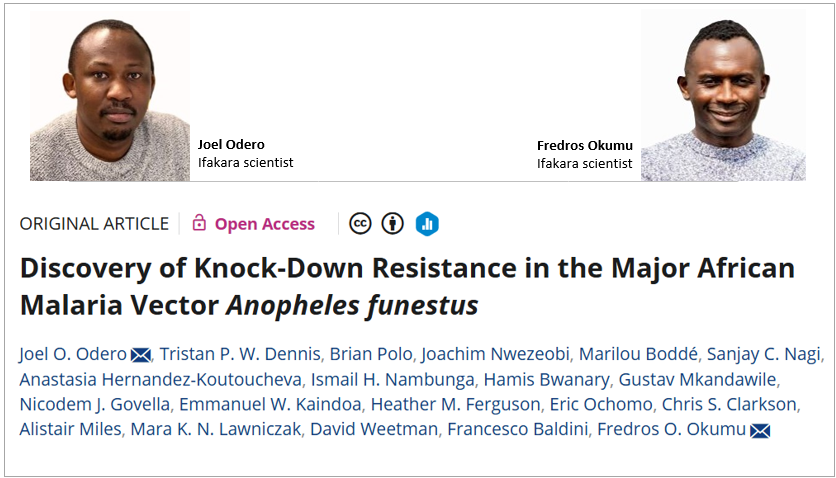
MALARIA CONTROL: Resistance in mosquito species raises concerns

In a recent study, scientists have raised concerns about the future of malaria control efforts due to emerging insecticide resistance, following the discovery of new genetic mutations in anopheles funestus, a major malaria-transmitting mosquito species in Tanzania.
Published on the Molecular Ecology journal and led by Ifakara Health Institute scientists Joel Odero and Fredros Okumu, the study investigates how these mosquitoes are adapting to withstand insecticides. Naturally, insecticide resistance arises from gene mutations known as knock-down resistance (kdr), but the new mutation had not previously been identified in An. funestus.
Discovery of knock-down resistance mutation
The team discovered eight new mutations, including one known as the “kdr L976F”, which makes the mosquitoes resistant to DDT—a pesticide that was once widely used but is now banned. In Tanzania, DDT has been banned since 2009 due to its harmful environmental and health effects.
Fortunately, according to the study findings, the kdr L976F mutation does not make the mosquitoes resistant to pyrethroids, a type of insecticide used in bed nets to protect against malaria.
“In this study, we report the findings of phenotypic and genomic surveillance done in Tanzania to understand the evolution and spread of insecticide resistance in Anopheles funestus... and report the first discovery of kdr mutations in An. funestus. We discover that, in Tanzanian An. funestus, kdr confers resistance to DDT, but not deltamethrin, despite a complete ban on DDT use for agriculture and vector control in Tanzania since 2008,” writes Odero and team.
Insights from Tanzanian genomic surveillance
The study focused on mosquito populations in Morogoro, where the kdr L976F mutation was found in up to 90% of the population over four years. Although the mutation has not spread widely to neighboring regions, its presence raises concerns about the possibility of future resistance to pyrethroids and other insecticides, which are crucial for malaria control.
These findings, according to Odero and his team, are important because, while the mutation does not currently affect pyrethroid-treated bed nets, monitoring its evolution will be critical to prevent future resistance.
Ongoing surveillance for malaria control
The scientists underscored the need for ongoing surveillance to track the mutation’s progress and its impact on other insecticides used in malaria prevention, including PBO-pyrethroid bed nets.
“The emergence of kdr resistance to DDT suggests that future use of DDT for IRS may become even less favoured,” wrote the scientists. “However, this does not preclude a role for kdr in the An. funestus IR armamentarium in the future and an urgent follow-up study is required to monitor the evolution of vector DDT resistance and determine whether kdr confer resistance phenotypes to other widely used pyrethroids, such as permethrin, and alpha-cypermethrin, as well as other insecticide families, especially PBO and pyrrole formulations currently being rolled out in new ITN products across the African continent.”
Possible origins of the kdr L976F mutation
The study further explores the kdr L976F mutation, raising questions about its origin given that DDT has not been used in Tanzania for over a decade. The scientists suggest that the mutation may have developed from historical DDT use in agriculture or leftover contamination from old stockpiles, and possibly from illegal agricultural use. Although DDT was officially banned in Tanzania in 2009, the mutation’s presence in Morogoro suggests lasting environmental effects.
Continuous monitoring is essential
For now, scientists are reassured by the study’s findings that the L976F mutation does not affect the efficacy of pyrethroids. However, they stress that continuous monitoring is essential to avoid resistance that could undermine malaria control efforts in Tanzania and throughout Africa.
“Whether the emergence of kdr in An. funestus is caused by vector control, unlicensed DDT usage in agriculture, or exposure to stockpiled DDT, our findings underscore the legacy of Silent Spring by reinforcing the potential for pesticides and organic pollutants to exert inadvertent influences on animal biology that may have profound and unfortunate consequences for public health. Continued monitoring is necessary to understand the origin of kdr in An. funestus, and the threat posed to insecticide-based vector control in Africa.”
Ifakara scientists lead the study
The study was led by Ifakara scientists Joel Odero and Fredros Okumu in collaboration with colleagues from the Liverpool School of Tropical Medicine, Kenya Medical Research Institute, Wellcome Sanger Institute, and the University of Glasgow.
Read the publication here.
